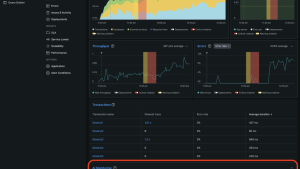In the ever-evolving landscape of digital applications, you must ensure uninterrupted performance and reliability. From understanding the core concepts to implementing a comprehensive resiliency checklist, we'll navigate the critical aspects of building applications that can withstand challenges and deliver seamless performance. Let's delve into how to navigate the complexities of modern applications and application performance monitoring (APM) with confidence.
Understanding application resiliency
Application resiliency involves ensuring applications can gracefully recover from unexpected failures, maintaining uninterrupted performance and enhancing user experience, ultimately leading to increased revenue. This facet of modern app development revolves around implementing strategies and components that boost an application's adaptability to diverse challenges.
Benefits of application resiliency
In a world where user expectations for seamless experiences are higher than ever, resilient applications become critical to user satisfaction and trust. Minimizing downtime and maintaining performance during adverse conditions—like peak demand times—ensures the success of digital initiatives. The benefits of application resiliency include but aren’t limited to enhanced reliability and availability, improved user satisfaction, protection against revenue loss during downtime, and adaptability to ever-changing conditions and evolving user demands.
Key components of application resiliency
- Fault tolerance: The ability of an application to continue functioning or gracefully degrade in the presence of faults or failures.
- Redundancy: Duplication of critical components or systems to ensure availability and mitigate the impact of failures.
- Scalability: The capability to handle increased load by efficiently allocating resources and distributing traffic.
Understanding these components is essential for strengthening resiliency with end-to-end observability.
The role of application resiliency in digital businesses
Application resiliency doesn’t just influence the technical aspects of software development; it also affects the overall success of digital initiatives. Businesses are increasingly adopting design principles and technology stacks that prioritize resiliency to meet the demands of today's digital consumers.
Design principles
At the heart of application resiliency lies the adoption of microservices architecture. Breaking down applications into smaller, independent services promotes fault isolation. If one service fails, it doesn’t bring down the entire application, ensuring other services can continue to function independently. This decentralized approach enhances the overall resiliency of the application.
Embracing cloud-native development principles is also synonymous with prioritizing resiliency. Cloud-native applications are designed to operate seamlessly in cloud environments, leveraging cloud services for scalability, redundancy, and fault tolerance. This approach allows businesses to build and deploy resilient applications that can adapt to changing conditions and scale effortlessly.
Technology stack
Load balancers are crucial in distributing incoming traffic across multiple servers, ensuring optimal resource utilization and preventing any single server from becoming a bottleneck. In the context of resiliency, load balancers enhance fault tolerance by redirecting traffic away from failed or degraded servers, contributing to uninterrupted service.
Content delivery networks (CDNs) enhance resiliency by distributing content across multiple geographically dispersed servers. This not only improves the performance of applications by reducing latency but also provides redundancy. If one server becomes unavailable, users can seamlessly access content from alternative servers within the CDN.
Lastly, the ability to dynamically scale resources in response to changing workloads is fundamental to application resiliency. Auto-scaling mechanisms ensure an application can handle increased demand without compromising performance or reliability. This adaptability is especially critical in dynamic and unpredictable environments.
The only application resiliency checklist you’ll need
Building and maintaining application resiliency requires a comprehensive approach that covers various aspects of your digital infrastructure. This checklist is your go-to guide for ensuring seamless performance and application modernization—even in the face of challenges.
1. Preparing for failures
Conduct a thorough analysis of your application architecture to identify critical components that could become potential points of failure. This proactive approach enables you to address vulnerabilities before they impact your users.
Leverage advanced monitoring solutions to gain real-time insights into your application's health. Monitoring helps in the early detection of issues, allowing your team to respond swiftly and prevent potential disruptions.
2. Redundancy strategies
Implement robust data replication strategies to ensure redundancy. In the event of data loss or system failure, having replicated data across multiple servers or locations ensures continuity of operations without compromising data integrity.
Distribute your application across multiple geographic locations. Geographic redundancy minimizes the impact of regional outages, providing users with uninterrupted service even if one region experiences disruptions.
3. Scaling strategies
Embrace horizontal scaling by adding more instances of your application to handle increased load. This strategy enhances resiliency by distributing workloads across multiple servers, preventing a single point of failure.
Additionally, vertically scale your infrastructure by increasing the capacity of individual components. Vertical scaling is crucial for applications with resource-intensive tasks, allowing them to handle larger workloads efficiently.
4. Recovery plans
Establish regular backup routines to safeguard your data. In addition, develop robust disaster recovery plans to swiftly restore operations in the event of a catastrophic failure.
Define and document incident response procedures to guide your team in addressing unexpected issues. Having well-defined procedures ensures a structured and efficient response, minimizing downtime and its associated impacts.
Why are testing and iterating important?
Ensuring the resiliency of your application begins with regular testing. This includes functional testing to validate that each component operates as intended and integration testing to identify potential issues when multiple components interact. Regular testing helps you catch vulnerabilities early on, allowing for timely fixes and preventing potential disruptions.
Conducting stress and load tests
Stress and load testing are paramount for understanding your application's performance under extreme conditions. By simulating heavy loads and stressing different aspects of your system, you can identify bottlenecks, weaknesses, and failure points. This proactive approach enables you to optimize your application's performance, enhance scalability, and fortify its resilience in the face of varying workloads.
Learning from failures
Every failure, no matter how minor, presents an opportunity to learn and improve. After conducting tests, it's essential to analyze the results—especially when failures occur. Learning from these failures lets your team identify root causes, implement corrective measures, and iterate on your application's design. This iterative process is fundamental to achieving software excellence and building a resilient, continually evolving system to meet emerging challenges.
Key takeaways
- Application resiliency is crucial for modern businesses, ensuring continuous availability, fault tolerance, and scalability.
- Design principles such as microservices architecture and cloud-native development enhance application resiliency.
- A robust technology stack, including load balancers, CDNs, and auto-scaling mechanisms, contributes to a resilient infrastructure.
- The application resiliency checklist covers preparing for failures, redundancy strategies, scaling approaches, and recovery plans.
Embracing a proactive approach to application resiliency involves regularly testing and iterating your systems. Stress and load testing, learning from failures, and continuous improvement are essential practices to strengthen your application's resilience.
With our advanced performance monitoring capabilities, New Relic empowers organizations to monitor, troubleshoot, and optimize application performance. By leveraging these tools, you can gain deep insights into your application's behavior, identify potential points of failure, and ensure a seamless user experience.
本ブログに掲載されている見解は著者に所属するものであり、必ずしも New Relic 株式会社の公式見解であるわけではありません。また、本ブログには、外部サイトにアクセスするリンクが含まれる場合があります。それらリンク先の内容について、New Relic がいかなる保証も提供することはありません。





